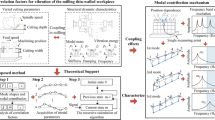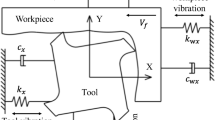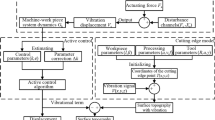Abstract
The intricate nature of milling vibrations stems from the existence of multiple vibration characteristics, encompassing free vibrations, chatter, and forced vibrations. The stiffness of the workpiece and cutting tool dramatically affects the milling vibration states where the stiffness variation can change the vibration states. This paper presents a comprehensive investigation on the effect of stiffness variation on milling vibration state for the first time. A intrinsic feature based on the spectrum characteristics and surface topography is extracted to distinguish the multiple vibration states, namely normal, chatter, and forced vibrations, across three types of milling scenarios: i) high stiffness workpiece and low stiffness tool; ii) low stiffness workpiece and high stiffness tool; and iii) both high stiffness. The vibration base frequency serves as an inherent feature, eliminating the need for setting thresholds based on different machining conditions. Milling experiments for each vibration type were performed in 28 sets at different spindle speeds and depths of cut. The results affirm that the proposed features accurately discern free vibrations, chatter, and forced vibrations across all three types of milling. Furthermore, it is found that there is a direct correspondence between the vibration base frequency of each vibration condition and the resulting surface topography. Notably, only chatter produces a new vibration base frequency, whereas the vibration base frequencies of normal and forced vibrations coincide with the spindle pass frequency.












Similar content being viewed by others
Data availability
All data generated or analyzed during this paper are included in this published article.
Code availability
Not applicable.
References
Zhu K, Zhang Y (2017) Modeling of the instantaneous milling force per tooth with tool run-out effect in high speed ball-end milling. Int J Mach Tools Manuf 118–119:37–48. https://doi.org/10.1016/j.ijmachtools.2017.04.001
Grossi N, Scippa A, Sallese L, Montevecchi F, Campatelli G (2018) On the generation of chatter marks in peripheral milling: a spectral interpretation. Int J Mach Tools Manuf 133:31–46. https://doi.org/10.1016/j.ijmachtools.2018.05.008
Dong X, Zhang W (2017) Chatter identification in milling of the thin-walled part based on complexity index. Int J Adv Manuf Technol 91:3327–3337. https://doi.org/10.1007/s00170-016-9912-6
Wu G, Li G, Pan W, Raja I, Wang X, Ding S (2021) A state-of-art review on chatter and geometric errors in thin-wall machining processes. J Manuf Process 68:454–480. https://doi.org/10.1016/j.jmapro.2021.05.055
Yuvaraju BAG, Srinivas J, Nanda BK (2023) Nonlinear dynamics of friction-induced regenerative chatter in internal turning with process damping forces. J Sound Vib 544:117386. https://doi.org/10.1016/j.jsv.2022.117386
Urbikain Pelayo G, Olvera-Trejo D, Luo M, López de Lacalle LN (2021) Surface roughness prediction with new barrel-shape mills considering runout: Modelling and validation. Measurement 173:108670. https://doi.org/10.1016/j.measurement.2020.108670
Wojciechowski S, Maruda RW, Krolczyk GM, Niesłony P (2018) Application of signal to noise ratio and grey relational analysis to minimize forces and vibrations during precise ball end milling. Precis Eng 51:582–596. https://doi.org/10.1016/j.precisioneng.2017.10.014
Wojciechowski S, Mrozek K (2017) Mechanical and technological aspects of micro ball end milling with various tool inclinations. Int J Mech Sci 134:424–435. https://doi.org/10.1016/j.ijmecsci.2017.10.032
Yang K, Wang G, Dong Y, Zhang Q, Sang L (2019) Early chatter identification based on an optimized variational mode decomposition. Mech Syst Signal Process 115:238–254. https://doi.org/10.1016/j.ymssp.2018.05.052
Ren Y, Ding Y (2022) Online milling chatter identification using adaptive Hankel low-rank decomposition. Mech Syst Signal Process 169:108758. https://doi.org/10.1016/j.ymssp.2021.108758
Fu Y, Zhang Y, Zhou H, Li D, Liu H, Qiao H, Wang X (2016) Timely online chatter detection in end milling process. Mech Syst Signal Process 75:668–688. https://doi.org/10.1016/j.ymssp.2016.01.003
Mou W, Zhu S, Jiang Z, Song G (2022) Vibration signal-based chatter identification for milling of thin-walled structure. Chin J Aeronaut 35:204–214. https://doi.org/10.1016/j.cja.2020.09.029
Cao H, Zhou K, Chen X, Zhang X (2017) Early chatter detection in end milling based on multi-feature fusion and 3σ criterion. Int J Adv Manuf Technol 92:4387–4397. https://doi.org/10.1007/s00170-017-0476-x
Ye J, Feng P, Xu C, Ma Y, Huang S (2018) A novel approach for chatter online monitoring using coefficient of variation in machining process. Int J Adv Manuf Technol 96:287–297. https://doi.org/10.1007/s00170-017-1544-y
Wang WK, Wan M, Zhang WH, Yang Y (2022) Chatter detection methods in the machining processes: a review. J Manuf Process 77:240–259. https://doi.org/10.1016/j.jmapro.2022.03.018
Shrivastava Y, Singh B (2021) Tool chatter prediction based on empirical mode decomposition and response surface methodology. Measurement 173:108585. https://doi.org/10.1016/j.measurement.2020.108585
Zhang Z, Li H, Meng G, Xu T, Cheng C (2016) Chatter detection in milling process based on the energy entropy of VMD and WPD. Int J Mach Tools Manuf 108:106–112. https://doi.org/10.1016/j.ijmachtools.2016.06.002
Liu C, Zhu L, Ni C (2018) Chatter detection in milling process based on VMD and energy entropy. Mech Syst Signal Process 105:169–182. https://doi.org/10.1016/j.ymssp.2017.11.046
Albertelli P, Braghieri L, Torta M, Monno M (2019) Development of a generalized chatter detection methodology for variable speed machining. Mech Syst Signal Process 123:26–42. https://doi.org/10.1016/j.ymssp.2019.01.002
Gao J, Song Q, Liu Z (2018) Chatter detection and stability region acquisition in thin-walled workpiece milling based on CMWT. Int J Adv Manuf Technol 98:699–713. https://doi.org/10.1007/s00170-018-2306-1
Wojciechowski S, Wiackiewicz M, Krolczyk GM (2018) Study on metrological relations between instant tool displacements and surface roughness during precise ball end milling. Measurement 129:686–694. https://doi.org/10.1016/j.measurement.2018.07.058
Tangjitsitcharoen S, Saksri T, Ratanakuakangwan S (2015) Advance in chatter detection in ball end milling process by utilizing wavelet transform. J Intell Manuf 26:485–499. https://doi.org/10.1007/s10845-013-0805-3
Miao H, Wang C, Li C, Yao G, Zhang X, Liu Z, Xu M (2022) Dynamic modeling and nonlinear vibration analysis of spindle system during ball end milling process. Int J Adv Manuf Technol 121:7867–7889. https://doi.org/10.1007/s00170-022-09805-w
Guo M, Ye Y, Jiang X, Wu C (2020) Comprehensive effect of multi-parameters on vibration in high-speed precision milling. Int J Adv Manuf Technol 108:2187–2195. https://doi.org/10.1007/s00170-020-05441-4
Chen D, Zhang X, Zhao H, Ding H (2021) Development of a novel online chatter monitoring system for flexible milling process. Mech Syst Signal Process 159:107799. https://doi.org/10.1016/j.ymssp.2021.107799
Xin S, Tang X, Wu J, Peng F, Yan R, Yang W (2023) Investigation of the low-frequency chatter in robotic milling. Int J Mach Tools Manuf 190:104048. https://doi.org/10.1016/j.ijmachtools.2023.104048
Acknowledgments
This work is supported by Tianjin Technical Innovation Guidance Special Foundation (No. 22YDTPJC00110), National Natural Science Foundation of China (No. 51705362), and Tianjin Research Innovation Project for Postgraduate Students (2021YJSB233). We would like to thank the Analytical & Testing Center of Tiangong University for scanning electron microscope.
Funding
This work is supported by Tianjin Technical Innovation Guidance Special Foundation (No. 22YDTPJC00110), National Natural Science Foundation of China (No. 51705362), and Tianjin Research Innovation Project for Postgraduate Students (2021YJSB233). We would like to thank the Analytical & Testing Center of Tiangong University for scanning electron microscope.
Author information
Authors and Affiliations
Contributions
LG contributed to Investigation, Methodology, Validation, Writing–original draft, and Writing–review & editing. CL contributed to Methodology, Writing–original draft, Writing–review & editing, and Supervision. ZH contributed to Experiments. WX contributed to Experiments and Data curation.
Corresponding authors
Ethics declarations
Conflict of interest
The authors declare that they have no competing financial interests or personal relationships that could have appeared to influence the work reported in this paper.
Ethical approval
Not applicable.
Consent to participate
Not applicable.
Consent to publication
Not applicable.
Additional information
Technical Editor: Jarir Mahfoud.
Publisher's Note
Springer Nature remains neutral with regard to jurisdictional claims in published maps and institutional affiliations.
Rights and permissions
Springer Nature or its licensor (e.g. a society or other partner) holds exclusive rights to this article under a publishing agreement with the author(s) or other rightsholder(s); author self-archiving of the accepted manuscript version of this article is solely governed by the terms of such publishing agreement and applicable law.
About this article
Cite this article
Gao, L., Liu, C., Hou, Z. et al. Experimental investigation on the multiple vibration characteristics of milling based on spectrum feature and surface topography analysis. J Braz. Soc. Mech. Sci. Eng. 46, 234 (2024). https://doi.org/10.1007/s40430-024-04814-0
Received:
Accepted:
Published:
DOI: https://doi.org/10.1007/s40430-024-04814-0




